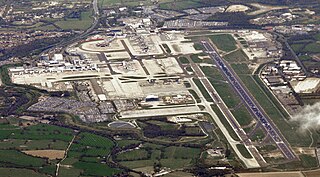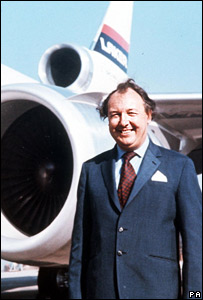Original agreement (1977)
Under the original 1977 version of Bermuda II, British Airways, Pan Am and Trans World Airlines were the only carriers allowed to operate flights between London Heathrow and the United States.
Air India, El Al, Iran Air and Kuwait Airways were permitted to continue exercising their so-called "fifth freedom" traffic rights from Heathrow to John F Kennedy International Airport (JFK), which they had already enjoyed under the original Bermuda agreement. (Both El Al and Iran Air stopped exercising these rights. The former decided that it made better economic sense to fly non-stop between Tel Aviv and New York. The latter's US traffic rights were withdrawn in the aftermath of the 1979 Iranian hostage crisis.) Similarly, Air New Zealand was allowed to continue using its fifth freedom rights between London and Los Angeles.
The extensive fifth freedom rights US carriers used to enjoy from the UK to other European countries were restricted to a few routes from London Heathrow to what used to be West Germany (including West Berlin) in the days prior to German reunification. In the early 1990s, United Airlines used to fly between Heathrow, Berlin, Hamburg and Munich (United had acquired these traffic rights along with Pan Am's transatlantic rights to/from Heathrow for US$1billion in 1990). A few years earlier, Trans World Airlines flew between London and Brussels but, unlike United, did not have traffic rights to carry local traffic between the two cities.
American and British regulatory authorities needed to approve every airline's capacity and pricing ahead of each operating season. Each country could refuse traffic rights to a carrier it was not satisfied with, particularly with regard to ownership and/or control. Only a specified number of US "gateway cities" could be served by both UK and US carriers from London Heathrow as well as London Gatwick.
Only the following US gateway cities could be served non-stop from Heathrow: Baltimore, Boston, Chicago–O'Hare, Detroit, Los Angeles, Miami, New York–JFK, Newark, Anchorage, Minneapolis/St. Paul, Philadelphia, San Francisco, Seattle/Tacoma, and Washington–Dulles. Anchorage and Minneapolis/St. Paul, held dormant authorities to use Heathrow as their London terminal, grandfathered from use during the original Bermuda Agreement; but could only be operated non-stop by a British carrier. As such, Anchorage remained dormant during the latter years of Bermuda II, and Minneapolis featured service only to London Gatwick, as its operating carrier (Northwest Airlines) did not have the authority to operate into Heathrow.
Other airports in the United States had to be served from Gatwick rather than Heathrow: these eventually included Atlanta, Charlotte, Cincinnati, Cleveland, Dallas/Fort Worth, Houston–Intercontinental, Las Vegas, Nashville, New Orleans, Orlando, Pittsburgh, Raleigh/Durham, St. Louis, and Tampa.
A provision existed that allowed any Heathrow-authorised British carrier operating as the sole carrier between London Gatwick and any US city to switch that service to Heathrow as long as the incumbent airline had demonstrated its ability to carry a minimum of 300,000 non-stop passengers (both transfer and point-to-point) between that city and London, and vice versa, over a period of two consecutive calendar years. Using this method, British Airways was able to transfer Denver, Kolkata, San Diego and Phoenix-Sky Harbor services from Gatwick to Heathrow in 2002.
Bermuda II continued and expanded the principle of "dual designation", i.e. the right to designate two UK airlines as well as two US carriers as "flag carriers" on the same routes, which already existed on the London–New York and London–Los Angeles routes under the original Bermuda treaty.
Under the new agreement, BCal had its licences to commence scheduled services from its Gatwick base to both Houston and Atlanta confirmed and was designated as the UK's exclusive flag carrier on both routes. It also obtained a licence and sole UK flag carrier status to commence scheduled services from Gatwick to Dallas/Fort Worth. In addition, BCal obtained a licence and sole UK flag carrier status to commence scheduled all cargo flights between Gatwick and Houston – including an optional stop-over at Manchester or Prestwick in either direction.
The UK Government chose to designate Laker Airways rather than BCal as the second UK flag carrier to New York to enable that airline to inaugurate its long-planned "Skytrain" operation on that route.
Moreover, both sides agreed to continue dual designation, i.e. designating two UK flag carriers as well as two US flag carriers, on the London–New York and London–Los Angeles routes. The principle of dual designation was extended to another two high-volume routes. The UK side chose to designate a second carrier on London–Miami, while the US side chose London–Boston for the same purpose. This meant that a second British airline was permitted to commence scheduled services on the former route, whereas another American carrier could do the same on the latter route. The UK government chose to designate Laker Airways as the second UK flag carrier on the Los Angeles and Miami routes, whilst the US government decided to designate Northwest as the second US flag carrier on London–Boston. (Pan Am and TWA continued in their role as the two designated US flag carriers between London and New York as well as London and Los Angeles respectively.)

During the Bermuda II negotiations, the UK side succeeded in having inserted into the new air services agreement a clause stating that Gatwick – rather than Heathrow – was to be nominated as the designated US flag carrier's London gateway airport whenever BCal was going to be the sole designated UK flag carrier on the same route. This clause was meant to support the growth of BCal's scheduled operation at Gatwick as well as to redress the competitive imbalance between it and its much bigger, more powerful rivals.
The UK side furthermore succeeded in negotiating a three-year "exclusivity" period for the incumbent operator on any new route with their US counterparts.
For Gatwick-based BCal this meant that it did not have to face any competitor that was using Heathrow, a more accessible airport with a bigger catchment area and a far greater number of passengers connecting between flights, on any of the new routes it was planning to launch to the US. It also meant that it had any new route to the US completely to itself for the first three years of operation, which most airline industry analysts reckon is sufficiently long for a brand-new scheduled air service to become profitable.
At British insistence Bermuda II furthermore contained clauses that made it illegal for any airline operating scheduled flights between the UK and the US to resort to predatory pricing or capacity dumping. Air fares were only approved if they reflected the actual cost of providing these services. Similarly, capacity increases were sanctioned on a reciprocal basis only. The reason for insisting on the inclusion of these provisions in the Bermuda II agreement was to prevent the much bigger, better financed and commercially far more aggressive US carriers from undercutting BCal with "loss-leading" fares cross-subsidised with profits those carriers' vast domestic networks generated as well as to stop them from "marginalising" the UK carrier by adding capacity far in excess of what the market could sustain.
Bermuda II also provided routing restrictions for flights between the United States and various British overseas colonies including Bermuda, various Caribbean islands and Hong Kong as well as India, where airports such as Hyderabad, Bangalore, Kochi, Colombo, Male could only be served from Gatwick.









